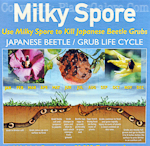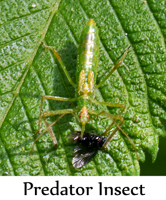 Starting in the late
1940s or early 1950s, chemists began to concoct new
chemicals called synthetic pesticides. The consuming
public from farmers to backyard gardeners eagerly
latched onto these "wonder" products. All they had
to do was spray a little of this stuff on their
fruit, vegetables, lawns and ornamental plants and
all insect and disease problems would vanish. The
strongest chemicals only had to be applied once
because they would stay around for a long time. One
of those products, Chlordane was said to remain in
the soil for up to 10 years after an application.
Starting in the late
1940s or early 1950s, chemists began to concoct new
chemicals called synthetic pesticides. The consuming
public from farmers to backyard gardeners eagerly
latched onto these "wonder" products. All they had
to do was spray a little of this stuff on their
fruit, vegetables, lawns and ornamental plants and
all insect and disease problems would vanish. The
strongest chemicals only had to be applied once
because they would stay around for a long time. One
of those products, Chlordane was said to remain in
the soil for up to 10 years after an application.
In the past few
decades, there has been a growing awareness that we
can actually work with Mother Nature to protect our
precious plants from serious damage. In nature,
things tend to strive toward an equilibrium between
the prey (or food) and the predators that feed upon
them.
 Understanding this
predator/prey relationship is important when
considering biological control measures. The
commonly used biological controls include pathogens
(diseases), parasitoids, parasites and consuming
organisms. All of these do their good work in either
weakening or killing organisms that we gardeners
call pests in our landscape.
Understanding this
predator/prey relationship is important when
considering biological control measures. The
commonly used biological controls include pathogens
(diseases), parasitoids, parasites and consuming
organisms. All of these do their good work in either
weakening or killing organisms that we gardeners
call pests in our landscape.
All of the biological
control options have similar characteristics:
-
They take a while to
become effective - Unlike chemical
pesticides which often kill on contact,
biological options take time to become
established in your landscape.
-
They do not eliminate the
pest - Remember that, if the control
organism eats all of its available food supply,
they will die off or move away. Therefore, the
hope is that the good guys and bad guys fall
into a cycle where the bad guys are kept at a
level acceptable to the gardener. You have to
have both types to have true biological control.
-
They are living organisms
too - In order to maintain a
biological control strategy over time, you will
have to stop spraying other pesticides in the
area or be extremely careful of what and how you
use chemicals. So-called "broad spectrum"
pesticides kill indiscriminately. They cannot
distinguish between the good and the bad
organisms
The following is a
brief discussion of the major products used as
biological controls.



